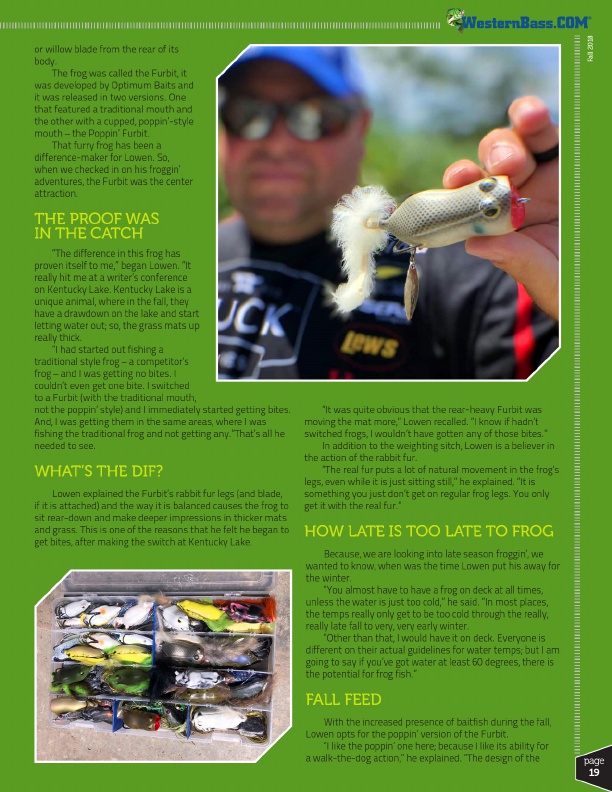
®
or willow blade from the rear of its body.
The frog was called the Furbit, it was developed by Optimum Baits and it was released in two versions. One that featured a traditional mouth and the other with a cupped, poppin’-style mouth – the Poppin’ Furbit.
That furry frog has been a difference-maker for Lowen. So, when we checked in on his froggin’ adventures, the Furbit was the center attraction.
THE PROOF WAS IN THE CATCH
“The difference in this frog has proven itself to me,” began Lowen. “It really hit me at a writer’s conference on Kentucky Lake. Kentucky Lake is a unique animal, where in the fall, they have a drawdown on the lake and start letting water out; so, the grass mats up really thick.
“I had started out fishing a traditional style frog – a competitor’s frog – and I was getting no bites. I couldn’t even get one bite. I switched to a Furbit (with the traditional mouth, not the poppin’ style) and I immediately started getting bites. And, I was getting them in the same areas, where I was fishing the traditional frog and not getting any.”That’s all he needed to see.
WHAT’S THE DIF?
Lowen explained the Furbit’s rabbit fur legs (and blade, if it is attached) and the way it is balanced causes the frog to sit rear-down and make deeper impressions in thicker mats and grass. This is one of the reasons that he felt he began to get bites, after making the switch at Kentucky Lake.
“It was quite obvious that the rear-heavy Furbit was moving the mat more,” Lowen recalled. “I know if hadn’t switched frogs, I wouldn’t have gotten any of those bites.”
In addition to the weighting sitch, Lowen is a believer in the action of the rabbit fur.
“The real fur puts a lot of natural movement in the frog’s legs, even while it is just sitting still,” he explained. “It is something you just don’t get on regular frog legs. You only get it with the real fur.”
HOW LATE IS TOO LATE TO FROG
Because, we are looking into late season froggin’, we wanted to know, when was the time Lowen put his away for the winter.
“You almost have to have a frog on deck at all times, unless the water is just too cold,” he said. “In most places, the temps really only get to be too cold through the really, really late fall to very, very early winter.
“Other than that, I would have it on deck. Everyone is different on their actual guidelines for water temps; but I am going to say if you’ve got water at least 60 degrees, there is the potential for frog fish.”
FALL FEED
With the increased presence of baitfish during the fall, Lowen opts for the poppin’ version of the Furbit.
“I like the poppin’ one here; because I like its ability for a walk-the-dog action,” he explained. “The design of the
Fall 2018
page
19